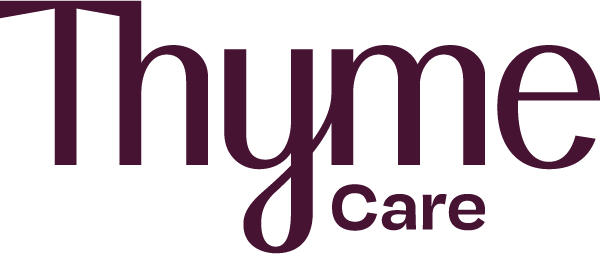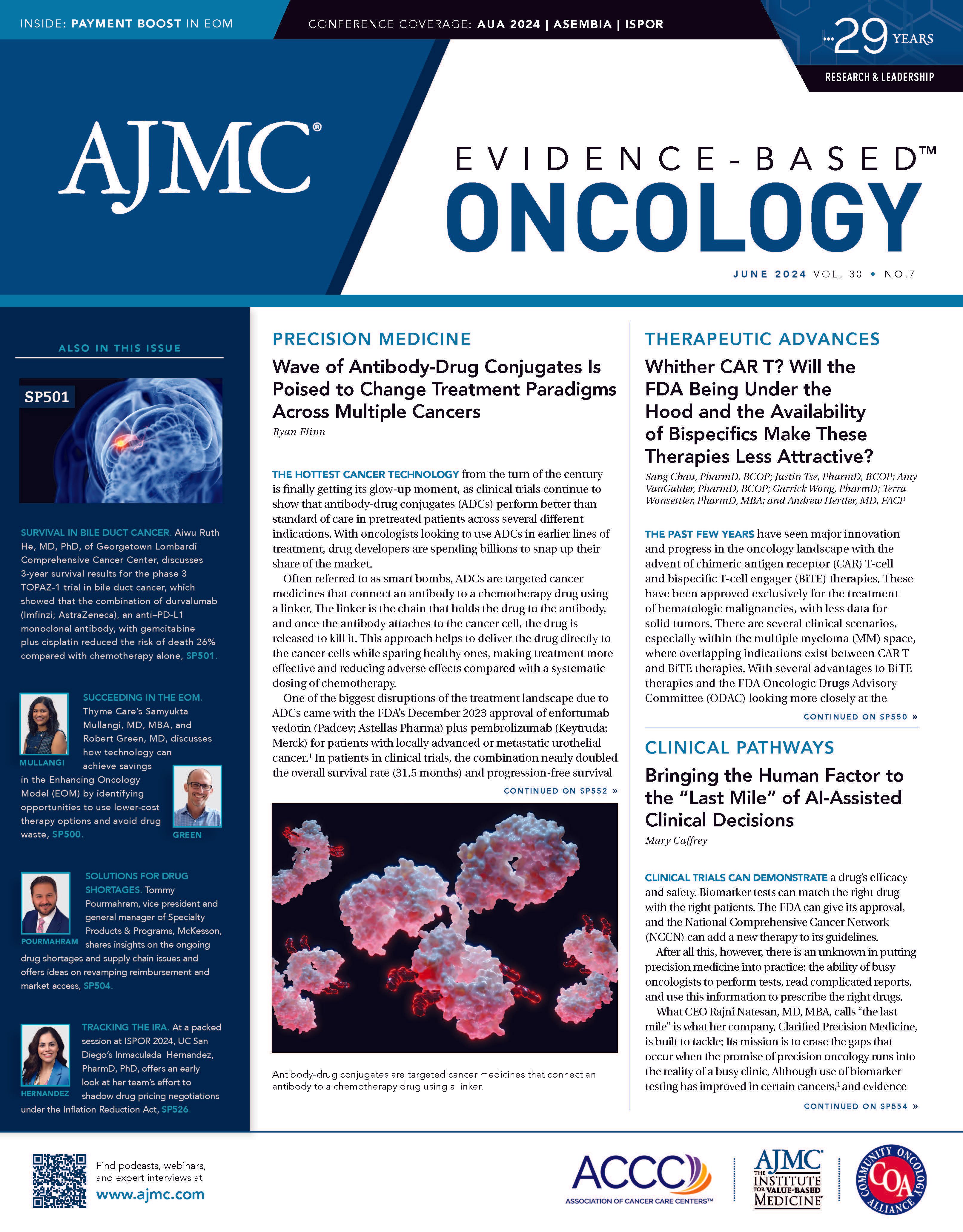Publication
Article
Evidence-Based Oncology
How Thyme Care Drives Reductions in Drug Spend in the Enhancing Oncology Model
Author(s):
The Enhancing Oncology Model (EOM) is an alternative, value-based payment model from the Center for Medicare and Medicaid Innovation (CMMI), launched in July 2023.1 Participating practices assume mandatory downside risk on the total cost of care for Medicare beneficiaries with 1 of 7 common cancer types undergoing systemic drug treatment. Additionally, practices must assure a minimum savings for CMS; in other words, they must clear a certain hurdle before they can access any sort of shared savings.
Samyukta Mullangi, MD, MBA | Image credit: Thyme Care

Value-based care, in its earliest iterations of messaging, was often synonymized with attempts to reduce acute care utilization—essentially keeping patients healthy in their communities and out of the hospital in order to both improve care quality and reduce costs, as such hospitalization can be very expensive.
Robert Green, MD | Image credit: Thyme Care

Value-based care activities that aim to reduce acute care utilization include proactive symptom management and care coordination across multiple providers. While this approach and philosophy are correct, and vital to ensuring a patient’s well-being while navigating a complex and confusing health care environment, it is likely insufficient as a stand-alone strategy in cancer.
Another way to frame this is by studying the cost drivers in varying conditions, such as a joint replacement vs chronic kidney disease vs cancer. In the first example, costs are likely driven by surgery and associated hospitalization and rehab; in the second, by crash dialysis starts and kidney transplantation; and in the third, by both hospitalization use and the ever-escalating prices of systemic therapies. Nearly a decade ago, around the start of CMMI’s last oncology value-based payment model, the Oncology Care Model (OCM),3 studies indicated that drug costs accounted for just over half the total cost of care in an average 6-month cancer treatment episode (acknowledging some heterogeneity here by primary cancer diagnosis).4 That same analysis found that by the end of OCM’s run, in 2021, cancer drug costs had climbed up to account for over 71% of the total cost of care.4 Thus, attempting to secure value in cancer care delivery by driving cost savings necessarily involves addressing drug spend as the largest driver.
Thyme Care logo | Image credit: Thyme Care

Insurers are well aware of the proliferating spend levels in cancer drugs and oftentimes respond with a variety of utilization management strategies such as prior authorization, step-edits, and formulary management.5 However, such strategies bear the risk of adding administrative complexity and requiring additional staffing on the part of the practice to manage, and over time lead to provider abrasion. As a cancer-focused, value-based care enablement company, Thyme Care partnered with a large multipractice community oncology group to enter as a participant in the EOM and stand up a robust and comprehensive program for Medicare beneficiaries.6 Thyme Care’s strengths include deep data science, actuarial and oncology-specific domain expertise, and 2-way data integrations into the electronic health record with our partner practices. These allow the clinical team to make thoughtful and nuanced recommendations for cancer drug prescribing and dispensing in a way that is aligned with oncologist and oncology pharmacist workflows and logistic realities. Additionally, the hypothesis was that this personalized approach (at the clinic level) would yield better physician buy-in than traditional utilization management strategies.
In evaluating the universe of such drug recommendation opportunities, the Thyme Care clinical expert team prioritizes 5 key elements for every idea, as follows:
1. Cost. We filter drugs by cost (to the payer, CMS in this case) to narrow opportunities to a small cohort of high-cost anticancer and supportive drug therapies.
2. Volume. We narrow this list further to those used across our partner practices in sufficient enough volume to meaningfully impact the total cost of care.
3. Effort. Knowing that any drug prescribing recommendation will likely come at the cost of some amount of education, discussion, proactive or retroactive correction, and monitoring, we characterize opportunities by the degree of effort it will incur on the part of the provider or pharmacist.
4. Economics. We stay mindful of the fact that many drug prescribing recommendations in any value-based program need to take into consideration not only the savings to the health plan but also cost to patients, practice economics, and practice workload. Ongoing practice financial sustainability and growth in value-based care models are key factors in consideration.
5. Efficacy. A true North Star is ensuring that none of our proposed interventions will compromise the overall efficacy of the patient’s treatment regimen.
This framework inculcated great discipline in the Thyme Care team’s decision-making process and inspired confidence in our partnered practices, who knew that we were being thoughtful and intentional in our recommendations. For EOM, it allowed a narrowing of focus to 3 select recommendations in the first performance period (the second half of 2023), and then led a natural expansion to more recommendations in the second performance period (the first half of 2024).
The first 3 recommendations for drug prescribing followed 2 broad principles, as follows:
PRINCIPLE 1. Optimizing for therapeutic interchange of products where equally efficacious but less expensive alternatives exist.
Within this category, we made recommendations for biosimilar choices that can drive savings. An example is to analyze and recommend the most cost-effective bevacizumab biosimilar.7
We also made recommendations for equivalent products that are not exactly biosimilars but fall into the same category of effect. An example is to recommend zoledronic acid in place of denosumab as a bone-modifying agent when renal function allows this swap and it is appropriate for a given patient.8
PRINCIPLE 2. Minimizing drug waste.
Within this category, we made recommendations for dose-
optimization strategies that allow for more personalized dosing approaches for patients without loss in drug efficacy. An example is to recommend a weight-based dosing approach for pembrolizumab rather than a flat dose that assumes that the average patient weighs 100 kg.9
Identifying opportunities and making recommendations is only part of the story. Change management is equally if not more important, given that practices vary greatly in their operational workflows, provider enthusiasm for change, and resource availability—particularly in the form of pharmacist resourcing, technology sophistication, and administrative complexity.
We conducted extensive stakeholder interviews to map practice workflows, from the point of patient intake and disease and demographic variable capture to oncologist decision-making cadence and workflow and the process through which a chemotherapeutic regimen was ordered. We studied how each order was then interacted by a variety of intermediate personnel such as prior authorization coordinators, financial assistance navigators, and pharmacists, through fulfillment by pharmacy technicians or nursing personnel.
We built solutions that worked given the heterogeneity that can exist along these measures, not just across different practices but also across different clinic sites within the same practice. Managing to this degree of specificity involved experimenting with different meeting formats, cadence, data file formats, custom dashboards, automation, and audit processes.
To secure physician, pharmacist, and nursing buy-in, we instituted several educational outreach efforts, including presentations to the practice’s pharmacy and therapeutic committee; educational content in the chief medical officer’s newsletter; practice-by-practice educational presentations to physicians and nurses; 1-pagers distributed to practices and pharmacists; and, most innovatively, real-time prescribing guidelines enabled through an electronic health record–integrated decision support overlay.
These 3 recommendations alone collectively drove substantial savings to Medicare within 8 weeks of implementation and were operationally and economically feasible for the practices. The ethos of value-based care is best manifested in such outcomes—practices and payers aligned in interventions that result in ecosystem savings because they are ultimately shared between both parties. Patients ultimately benefit as well through an impact on their out-of-pocket outlays within the fiscal year and a mitigation on insurance premiums in subsequent years.
With the advent of the new year, across both EOM as well as other value-based agreements with payers and at-risk primary care physicians, the Thyme Care clinical team continues to surface opportunities to partner practices, but ultimately the practice determines whether or not to move forward with a clinical intervention after assessment of all the benefits and trade-offs. We believe that such a light-touch recommendation engine that allows practices to have the final say in greenlighting interventions is key to success. Our ultimate goal is to empower practices through a mix of developing clinical understanding and removing as many relevant roadblocks as possible in execution—however, as an enablement partner, we consider ourselves a practice’s ally in value-based care, not an encumbrance.
About the Authors
Samyukta Mullangi, MD, MBA, is a medical oncologist with Tennessee Oncology, based in Dickson, Tennessee, and is the medical oncology director for Thyme Care. Robert Green, MD, is the president and chief medical officer for Thyme Care.
For correspondence: Samyukta Mullangi, MD, MBA, 103 Natchez Park Dr, Suite 103, Dickson, TN 37055; sam@thymecare.com.
References
1. Enhancing Oncology Model. Centers for Medicare & Medicaid
Services. Updated June 27, 2023. Accessed May 15, 2024. https://go.cms.gov/3Qp1Ppt
2. Gondi S, Li Y, Antol DD, Boudreau E, Shrank WH, Powers BW. Analysis of value-based payment and acute care use among Medicare Advantage beneficiaries. JAMA Netw Open. 2022;5(3):e222916. doi:10.1001/jamanetworkopen.2022.2916
3. Oncology Care Model. Centers for Medicare & Medicaid Services. Accessed May 15, 2024. https://go.cms.gov/3yw975l
4. Owens L, Bilbrey LE, Dickson NR, et al. Trend in breakdown of
total cost of care for medical oncology over time: learnings from the Oncology Care Model and implications for future oncology value-based care. JCO Oncol Pract. 2023;19(suppl 11). doi:10.1200/OP.2023.19.11_suppl.69
5. Patt DA. Understanding utilization management policy: how to manage this increasingly complex environment in collaboration and with better data. Am Soc Clin Oncol Educ Book. 2018;38:135-138. doi:10.1200/EDBK_200891
6. Shah R, Green B, Diephuis B. Our responsibility to bring a better cancer journey to scale. Thyme Care Inc. August 22, 2023. Accessed May 15, 2024. https://bit.ly/3ykc1Kt
7. Patel KB, Arantes LH Jr, Tang WY, Fung S. The role of biosimilars in value-based oncology. Cancer Manag Res. 2018;10:4591-4602. doi:10.2147/CMAR.S164201
8. Ford J, Cummins E, Sharma P, et al. Systematic review of the clinical effectiveness and cost-effectiveness, and economic evaluation, of denosumab for the treatment of bone metastases from solid tumours. Health Technol Assess. 2013;17(29):1-386. doi:10.3310/hta17290
9. Goldstein DA, Ratain MJ, Saltz LB. Weight-based dosing of pembrolizumab every 6 weeks in the time of COVID-19. JAMA Oncol. 2020;6(11):1694-1695. doi:10.1001/jamaoncol.2020.2493

Newsletter
Stay ahead of policy, cost, and value—subscribe to AJMC for expert insights at the intersection of clinical care and health economics.





